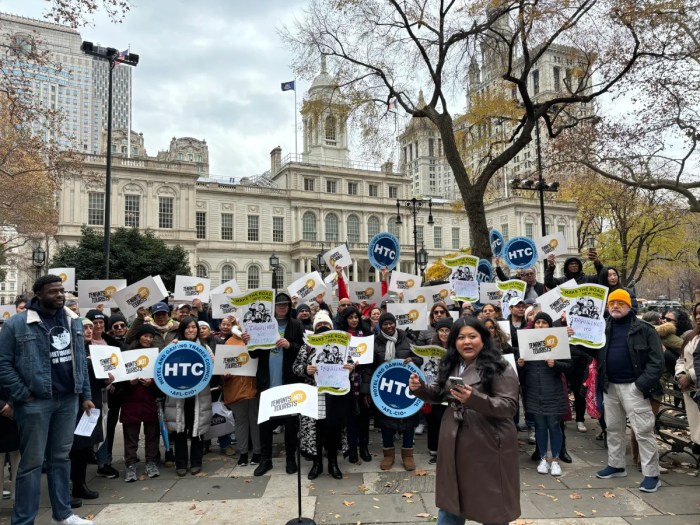POLITICAL NEWS Analysis
(AP) Gov. Andrew Cuomo’s budget presentation on Tuesday, Jan. 17, expected to steer the Democrat back toward fiscal conservatism from the liberal bend he’s been on since December.
Politically, that’s wise. Fiscally, it’s unavoidable.
Cuomo’s proposal to the Legislature will include the price of that left turn: $1.9 billion in new spending from the millionaire tax agreed to in December with a rare, but modest middle-class tax cut; a promised $1.4 billion increase in funding for public schools and health care pushed by lawmakers for this election year; $250 million the state will pay to a New York City transit agency for agreeing to reduce the city’s transit payroll tax to please suburban voters; and $50 million promised to upstate communities still trying to recover from late summer floods.
It adds up to a fourth consecutive difficult fiscal year for New York, with fewer tools available to dig out after years of deep cuts in state services and some layoffs. State agencies are told to expect 2.5 percent cuts, this after cuts of 30 percent since the recession began. The millionaire tax trims the deficit, but that shortfall is still $2 billion.
The state’s $130 billion-plus budget determines if teachers and nurses are hired or face layoffs, if class sizes grow, if bridges and roads are rebuilt and if nonprofit groups still provide services from homeless shelters to health care and meals for the elderly. Cuomo’s latest pledge to not raise state taxes or fees-and to mean it this time-will put more pressure on local governments and schools to raise property and sales taxes.
It wasn’t supposed to be this way.
A state economic forecast issued during the 2009-10 fiscal year predicted that New York’s nightmare would end in the second half of 2010.
“Now it looks like it’s going to be into 2015,” said Mark LaVigne of the New York State Association of Counties.
Counties and their taxpayers are being squeezed by rapidly rising costs of Medicaid health care for the poor and public pension payments. Cities, towns and villages are waiting to see if municipal aid is cut in Tuesday’s speech, another blow to their taxpayers but one of the few areas left to cut.
While most states report slow fiscal improvement, New York is among just four states-California, Missouri and Washington are the others-that reported a budget gap halfway through their 2011-12 budget year, according to the National Conference of State Legislatures. Most states ex- pect to meet or exceed their revenue targets, according to the NCSL’s midyear report, with New York and Delaware missing even a reduced projection for corporate income tax collections. New York’s revenue outlook was lowered for the remainder of 2012 “to meet lower expectations,” the NCSL report stated.
Washington’s need to cut spending and debt and continued economic volatility abroad darkened the outlook. In New York, not even Wall Street’s rebound is saving the state this time as bonus checks and the taxes they generate are increasingly deferred.
“Economic growth remains sluggish and the economy, fragile,” state Comptroller Thomas DiNapoli said last Friday, Jan. 13.
That Friday he released his report on the third quarter of the current fiscal year, and it wasn’t pleasant news for Cuomo. DiNapoli found that December tax collections were down 2.7 percent from a year before. By the end of 2011, however, overall revenues were nearly 8 percent higher than a year before in a slow recovery of fits and starts.
It already seems a long way from Cuomo’s rousing and optimistic State of the State speech Jan. 4 when he bellowed: “The best is yet to be. They ain’t seen nothin’ yet!”
Cuomo called for a jobs program to fix crumbling roads and bridges, support of a casino company’s private venture to build the nation’s biggest convention center at Aqueduct race track in Queens, $25 billion in economic development grants and tax breaks to employers, and major expansion of gambling, a common crutch for Albany.
“He gave a progressive agenda in the speech, but I think in the end you aren’t going to see anything different than in the first budget,” Lawrence Levy, a political commentator and dean of Hofstra University’s National Center on Suburban Studies.
That first Cuomo budget a year ago addressed a $10 billion deficit and made a small but rare spending cut that was supposed to be much of the pain to fix the “functionally bankrupt” Albany he inherited.
Then it got worse.
A surprise $350 million deficit emerged last fall and, under pressure from his progressive base to cut spending no more, Cuomo reversed his opposition to a millionaire tax, which he had argued would kill jobs, and ended up supporting it.
“I want to see how they are going to close the budget deficit, what their revenue projects are,” Levy said. “That gives an early warning sign of potential gimmicks.”
Cuomo’s father, Gov. Mario Cuomo, once resorted to such ploys by selling Attica state prison to another state agency, in a kind of political shell game that led to almost routine use of gimmicks and “oneshot” revenues-moves that contributed to the overspending “death spiral” that helped usher Andrew Cuomo into office in 2010.
One of the biggest one-shots on the table is the conversion of the Emblem health insurer from a nonprofit to a for-profit company. The state’s approval could result in $1 billion in the release of funds that were collected for the public good.
Other options include borrowing from pension funds and selling state assets. Asset sales could including selling off state office buildings or even privatizing services such as the state lottery.
“Asset sales and one-shots are the danger, and then hoping the economy grows enough to get them out of their mess,” said Richard Brodsky, a former Democratic assemblyman from Westchester who is now a senior fellow at the Wagner School at New York University. “This will be a real test of fiscal discipline.”




































